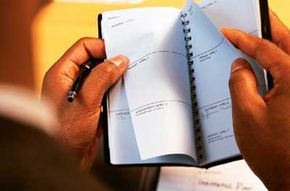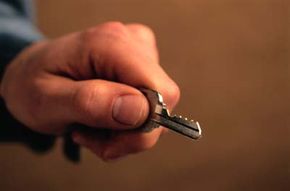Kara doesn't much like American history, and she's put off studying for the final exam on Friday. On Thursday night, she stays up and reads over each chapter from beginning to end. But when she sits down to take the test the next day, she can't seem to remember a thing that she read. What happened?
Kara went about studying for the test in the wrong way. Simply sitting down the night before and reading through the entire chapter, without questioning, commenting, or categorizing, with the vague hope that she'd remember what she read, is pretty much like throwing a batch of file cards into a box and hoping to remember what's on them later.
Unfortunately, Kara's study methods are pretty common among students. Studying for a test just by reading over the information one time will give you a retention rate of only about 20 percent, no matter how smart you are.
Fortunately, by learning some simple retention strategies, you can boost your recall to more than 80 percent. Memory strategies can help you learn spelling, vocabulary, a foreign language, names of historical figures, states and capitals, scientific terms, cities and primary products, U.S. presidents, foreign kings, basic math -- just about everything a person needs to learn in school or on the job.
There are three main ways to boost your memory of basic facts:
- by practicing active recall during learning
- by periodic reviews of the material
- by overlearning the material beyond the point of bare mastery
Involve Yourself in Reading!Instead of just reading, you need to read and think about what you're reading. Here are some suggestions for doing just that:
- Think of questions for yourself before, during, and after the reading session.
- Ask yourself what is happening next, why it's happening, and what would happen if one event or fact was different.
- Note what interests you. Take a moment to make a mental comment out loud.
- Train yourself to summarize, a section at a time. What are the main points in the text you just read? What are the logical conclusions?
Visualize as You ReadTry to imagine yourself in the place you're reading about, or try to imagine yourself doing what you're studying. Include yourself in images that you build in your mind. If you're reading about the Civil War, picture yourself on the battlefield. Why are you there? What is the enemy doing, and why? The better you can put yourself into a scene, the better you'll remember what you are reading.
Of course, it's much easier to visualize yourself in a battle than it is to link yourself to the major exports of Peru. Instead of just trying to visualize "wool, wheat, and corn," imagine you're a Peruvian farmer raising sheep and growing wheat and corn. This will work with just about anything, except perhaps for numbers and dates.
Take a Note!Taking notes won't help you if you scribble down the words in class without thinking about what you're writing, which is unfortunately the way too many students take notes.
The best way to take notes in class:
- Take them carefully while thinking about their content.
- Review them as you write.
- Summarize whenever possible. Isolate what's important and discard the rest while you're writing.
- Don't take down every word your teacher says.
PQRST MethodOne of the most popular techniques for remembering written material is the PQRST method: Preview, Question, Read, State, and Test. Memory experts think this works better than simple rehearsal because it provides you with better retrieval cues.
- Preview. Skim through the material briefly. Read the preface, table of contents, and chapter summaries. Preview a chapter by studying the outline and skimming the chapter (especially headings, photographs, and charts). The object is to get an overview of the book or chapter (this shouldn't take more than a few minutes).
- Question. Ask important questions about the information you're reading. If the chapter includes review questions at the end, read them before you begin reading the chapter and try to keep them in mind as you go. What are the main points in the text? How does the action occur? Read over the paragraph headings and ask yourself questions about them.
- Read. Now read the material completely, without taking notes. Underlining text can help you remember the information, provided you do it properly. The first time you read a chapter, don't underline anything (it's hard to pick out the main points the first time through). Most people tend to underline way too many things, which isn't helpful when you want to be able to go back later and review important points. Instead, read over one section and then go back and, as you work your way through each paragraph, underline the important points. Think about the points you're underlining.
- State. State the answers to key questions out loud. Reread the chapter and ask yourself questions and answer them out loud. Read what you've underlined out loud, and think about what you're saying. You should spend about half your studying time stating information out loud.
- Test. Test yourself to make sure you remembered the information. Go through the chapter again and ask questions. Space out your self-testing so you're doing it during a study session, after a study session, and right before a test. If you'd like, enlist the help of a friend to quiz you.
Make the Most of StudyingWhen you study is almost as important as how you study. It's better to schedule several shorter study sessions rather than one marathon all-nighter. This is probably because you can only concentrate for a certain period of time. If you try to study in one long session, you won't be able to maintain your concentration throughout. Breaks help you consolidate what you've learned.
On the other hand, you can overdo the short sessions as well -- scheduling too many short study sessions can be worse than cramming all of your studying into one marathon session. The trick is to determine the optimum length of a study session and how many sessions work best for you and for the material. Research suggests that difficult information or inexperienced students require shorter sessions for best results. If you have several subjects to study, it's better to separate them and spread them out over several days. You should also vary your learning methods: Take notes one day, make an outline the next, recite information out loud during the third study session.
You'll also want to avoid interference when you study. If you're boning up for a math test, don't close the math book and then read magazines, watch TV, and listen to music before going to bed. Study, then go to bed, so nothing else can interfere with what you've learned. Studies have also shown that sleeping between studying and testing is the best way to do well on a test. A person who sleeps right after studying will remember more than someone who stays awake.
It's also true that other activities between studying and the test will influence how well you remember. If you've spent several hours studying French, you shouldn't then study Latin before going to bed. In fact, if you have two very similar subjects to study, it's best not to study them in the same location.
First-Letter Cuing (Acronyms)The use of the first letter of a word as a cue to remembering the word itself can be helpful in remembering material. This cueing usually employs acronyms -- making a word out of the first letters of the words to be remembered. For example, it's possible to remember the Great Lakes using the acronym HOMES (Huron, Ontario, Michigan, Erie, Superior). Another related type of first-letter cueing is the acrostic, discussed previously, in which the first letters in a series of words form a word or phrase. For example, names of the strings of the viola (CGDA) can be remembered by the acrostic: Cats Go Down Alleys.
Because the acronym system is so effective, most organizations and governmental bodies make use of first-letter cueing: NATO (North Atlantic Treaty Organization) or AA (Alcoholics Anonymous). Some acronyms are so well known that the original full name has been all but forgotten, as in "scuba" (Self-Contained Underwater Breathing Apparatus) gear.
The only problem with first-letter cueing is the propensity to forget what the strategy has been used for. Therefore, it's a good idea to make the association remind you of the information to be remembered. Imagine HOMES floating on the Great Lakes, so that when you want to think of the names of all the lakes, the image of HOMES will return to you and with it, the first letter of each of the lakes.
Peg and LinkBoth the peg and linking systems that we discussed earlier also work well with studying school subjects. Review those methods and try practicing with them, especially for rote learning and memorization (such as a list of U.S. Presidents or the amendments to the Constitution).
To learn more about the various aspects of memory, see:
ABOUT THE AUTHOR:
Richard C. Mohs, Ph.D., has been vice chairman of the Department of Psychiatry at the Mount Sinai School of Medicine and associate chief of staff for research at the Bronx Veterans Affairs Medical Center. The author or co-author of more than 300 scientific papers, Dr. Mohs has conducted numerous research studies on aging, Alzheimer's disease, and cognitive function.
This information is solely for informational purposes. IT IS NOT INTENDED TO PROVIDE MEDICAL ADVICE. Neither the Editors of Consumer Guide (R), Publications International, Ltd., the author nor publisher take responsibility for any possible consequences from any treatment, procedure, exercise, dietary modification, action or application of medication which results from reading or following the information contained in this information. The publication of this information does not constitute the practice of medicine, and this information does not replace the advice of your physician or other health care provider. Before undertaking any course of treatment, the reader must seek the advice of their physician or other health care provider.




